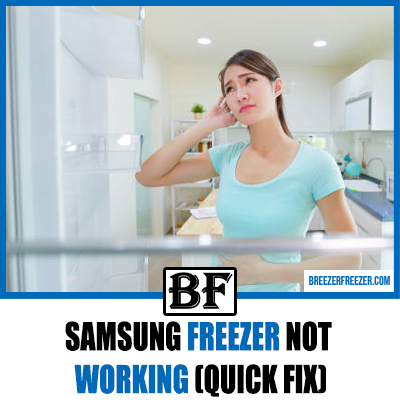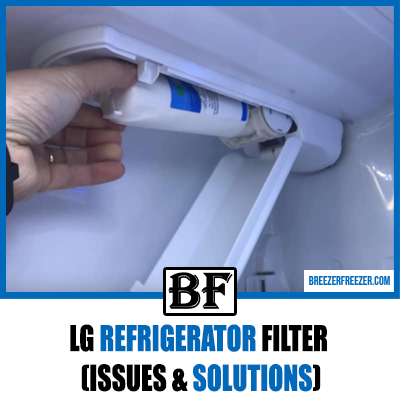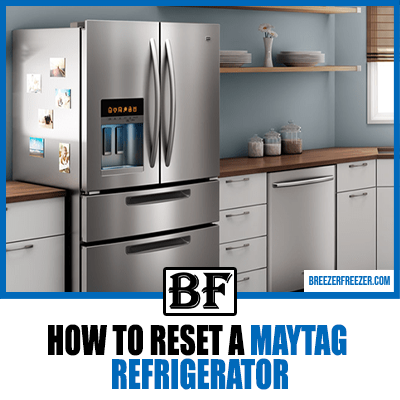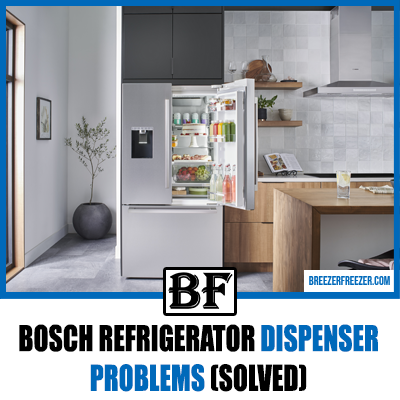Samsung Freezer Not Working (Quick Fix)
When it comes to home appliances, only a few brands are as popular as Samsung, and for good reason.

The South Korean technological giant has managed to build up its reputation by offering world-class products that make life easier and more comfortable.
This has helped it become a household name across the globe, and for many, when buying an air conditioner, TV, or refrigerator, this brand is the first choice.
Samsung refrigerators are especially popular, thanks to their quality, sleek design, and innovative features.
However, like any other appliances, these refrigerators can also develop problems, and freezers are the most common component that tend to malfunction. Unfortunately, getting them fixed at a service center can be quite costly.
That is why you should first try to fix a Samsung freezer at home, especially since it does not require a lot of skills and expenses. And, we’ve prepared this guide to help you fix your Samsung refrigerator. So, let’s begin!
Diagnosing Problems With Your Samsung Freezer
The first step to fixing problems with your Samsung freezer is conducting a proper diagnosis, and here are the steps for the process.
1. Checking The Basics

The best approach you should adopt when troubleshooting your Samsung refrigerator is to start with the basics. To do that, ensure the fridge is plugged in properly by removing the plug and re-inserting it into the socket firmly. Also, inspect the socket to make sure that it is in proper working condition.
You can also plug the refrigerator into another socket to check whether it turns on or not.
2. Turning Off The Demo Mode

If your Samsung refrigerator is plugged in and powered on but not working properly, it may be operating in demo mode. If that is the case, it will be indicated on the display of the refrigerator if there is one. Look at the display to see how to turn off the demo mode.
In many models, two buttons, Power Freeze and Freezer, need to be pressed and held for three seconds to turn off the demo mode.
3. Avoiding High Temperatures And Direct Sunlight

It is not a good idea to place your Samsung refrigerator in direct sunlight or near any other heat source (like a gas stove). If the refrigerator is in such a location, try to move it to a different one. And, if it is not possible, try to lower the temperature using the controls in both the refrigerator and the freezer.
The higher the outside temperature, the lower the temperature settings should be on your refrigerator. This will allow it to compensate for the heat and ensure that cooling takes place efficiently.
4. Ensuring Proper Ventilation

A refrigerator requires space around and behind it for optimal performance, allowing the air to circulate freely and cool the components, such as the condenser. If the freezer is not cooling properly, try to move the fridge away from the wall. There should be adequate space between it and the wall for proper air circulation.
5. Avoiding Overloading

If you have overloaded the freezer of your Samsung refrigerator with too many items, or the items are blocking various ducts and vents, it will not be able to cool properly. The items and draws should be removed and then cleaned or properly placed to allow the cold air to circulate properly.
Common Issues With Samsung Freezers
There may be several issues with your Samsung freezer, such as a faulty thermostat, incorrect temperature control, or others. And, these issues should be fixed as quickly as possible to prevent the situation from worsening. Here are some common issues you should be aware of.
1. Incorrect Temperature Settings
Wrong temperature settings are one of the most common problems with Samsung freezers, and can cause them to function inefficiently.
The recommended temperature for the freezer is around minus two degrees Fahrenheit, but any temperature under zero will keep your food fresh. Check the control panel or user manual to find out the ideal temperature for your Samsung freezer.
If the issue is with the temperature settings, try to change them first. You may need to reset the freezer temperature, so find the control panel. It may be located on the inside or outside of the freezer door. Click on the freezer button until it reaches the required temperature.
If that does not work, you may need to change the temperature control.
2. Faulty Evaporator Fan
Another common issue with Samsung freezers is faulty evaporator fans. The fan allows proper airflow throughout the freezer, and any defect with it can reduce its cooling. If you notice some unusual sounds coming from the evaporator motor, then it will need replacement.
To check whether the fan is working properly or not, carefully turn its blades which will allow you to notice if there’s any problem with the motor.
To do this, first, unplug the refrigerator and remove the evaporator fan cover. Check if there is any problem with the fan, and if there is none, put the cover back.
Then, turn the fridge back on and listen to the freezer fan. If you hear no sound, it means that the fan is not spinning. A faulty evaporator fan motor will require professional repair, so contact your nearest service center as soon as possible.
3. Malfunctioning Compressor
Listening to the compressor can help you learn whether there is any problem with the freezer. If a humming sound comes from the freezer, then the compressor is working perfectly. However, if the freezer is making unusual sounds instead of the low humming, unplug and replug the refrigerator to reset the compressor.
In most cases, this can fix the compressor, but if that does not happen, you may need professional help.
4. Frost Buildup On The Evaporator Coils
A common issue with Samsung refrigerators is that their evaporator coils tend to freeze quickly. It happens when warm air passes through the cold evaporator coils, condensing and freezing them. When the coils are iced over, the defrost cycle will not be able to solve this problem.
There may be various reasons why the evaporator coils of your freezer are freezing up. For instance, the freezer door may not be closing properly, which can let humid air into it.
Another cause can be the thermostat or defrost timer not functioning properly. In this case, it is best to contact a repair professional to get it repaired.
5. Dirty Condenser Coils
If the condenser coils under or behind the freezer are dirty, they will not be able to function optimally. This is because the dirt will trap the heat in the unit, causing inadequate cooling. To prevent that, clean the condenser coils once every three to six months.
To clean the coils, use a soft brush attachment with your vacuum cleaner that can suck up the debris or dust present under the unit. Follow this by wiping away any remaining dust with a rag, which will help avoid more costly repairs in the future.
6. Debris In The Freezer Vents
The freezer vents can become dirty, just like the condenser coils and will not be able to function properly when that happens. Make sure to check them periodically for dirt buildup.
Additionally, avoid placing food and packages close to the vents, which can block them and lead to improper ventilation.
When the freezer is not ventilated properly, hot and humid air builds up and leads to frost. This will prevent the freezer from getting cold enough and can ultimately spoil food.
7. Damaged Door Seal
As mentioned above, a worn-out or damaged freezer door seal can also lead to improper cooling. A damaged door seal will provide an inlet for warm air into the freezer, causing ice buildup in the freezer due to improper airflow.
In such a situation, the first step is to clean the seal, as dust and debris may cause the development of grooves in the seal. These grooves prevent the freezer door from closing properly, letting in the humid air.
Use hot water and dish soap to clean the seal properly, and then wipe it with a cloth. Once it is clean, use a dollar bill to check whether cleaning the seal has been beneficial.
Place the dollar bill on the edge of the freezer door and close it, then remove the bill. If it does not come out easily, the door seal does not need to be replaced.
On the other hand, if the seal is worn out and does not provide any resistance to the dollar bill, you will need to get it replaced.
8. Malfunctioning Condenser Fan Motor
If the condenser fan is damaged or obstructed, it will not be able to cool the freezer properly. To check it, first, make sure to unplug your Samsung refrigerator to ensure safety. Then check the fan to see whether its blades can move freely without obstruction.
Again, try spinning the blades by hand, like with the evaporator fan. If they do not spin freely, it is time to get them replaced. On the other hand, if the blade spins freely and there are no obstructions, use a multimeter to test the fan motor for continuity.
To test it, plug the refrigerator back into the power socket and turn it on, but keep your hands clear of the fan blades. If the motor does not have continuity, it needs to be replaced.
9. Faulty Start Relay
A malfunctioning start relay can lead to situations in which the compressor of the refrigerator may not run properly or fail to run at all. If that is the case, the freezer will not be cold enough.
So, check the relay using a multimeter and test it for continuity. If the start relay has no continuity between the start and run terminal sockets, it is time to get a new one.
Sometimes the relay can also burn out, in which case it will have a burnt odor and should be replaced.
10. Defective Thermostat
The temperature control thermostat is responsible for maintaining the ideal temperature for cooling. It can cause problems when it gets damaged. A defective thermostat can prevent the refrigerant system from running properly, so the first step is to check its performance.
To do so, turn the thermostat from the lowest to the highest setting until you hear a click. If it clicks, there is no problem with the thermostat, and the issue lies elsewhere.
However, if you cannot hear the click, use a multimeter to test the thermostat for continuity in different settings.
If there is no continuity in any setting, we suggest contacting Samsung customer service to get it replaced.
11. Problems With The Start Capacitor
It is the function of the capacitor to boost the compressor when you turn it on, and if it is faulty, the compressor may not start. Use a multimeter to check for continuity in the capacitor, and get it replaced if there is none.
12. Defective Temperature Control Board
The temperature control board sends the correct voltage to the cooling system of the Samsung freezer, which it may not be able to do if it is defective.
But, before replacing the entire board, it is a good idea to check other components that are generally more prone to damage.
This is because it is easy to misdiagnose control boards, and replacing them can be quite expensive and also require a significant amount of time.
13. Faulty Thermistor
The thermistor in a refrigerator senses changes in the temperature and sends a signal to the temperature control board when it detects such a change.
If it malfunctions, other components like the compressor and evaporator fan, which depend upon the signal from the control board, may not run.
Use your multimeter to check whether the thermistor resistance changes along with the refrigerator temperature. If the resistance does not change, the thermistor has no continuity and will require replacing.
Solutions For Fixing A Malfunctioning Samsung Freezer
Before taking your refrigerator to the nearest Samsung support center, there are a few things that you can try out to resolve the issue. Most of these quick fixes can be performed easily without expertise or skill and will not take much time.
1. Replacing The Power Cord
The first step is to ensure that the power cord of the refrigerator is plugged into the socket properly. Also, it is recommended to use a dedicated wall socket for your Samsung fridge rather than an extension since the latter reduces the amount of power received by the freezer.
Once you are sure that the power cord is plugged in properly, remove it and plug another appliance into the socket to check whether there is sufficient voltage.
You should also check the circuit breaker of the wall outlet and reset it if the appliance does not turn on.
Also, inspect the power cord for signs of damage and if you find any, contact the support center and request a replacement.
2. Relocating The Refrigerator
If your Samsung refrigerator is placed under direct sunlight, try to relocate it, which will help keep the freezer at a cooler temperature. Additionally, the freezer can overheat if there is any other heat source close to it or if there is inadequate ventilation.
The temperature of the location should be suitable for the freezer to function optimally. Ideally, this temperature should lie between 55 degrees Fahrenheit and 110 degrees Fahrenheit.
In some cases, it may not be possible to relocate the freezer, so you will have to lower the temperature of the freezer for more efficient cooling. And, to ensure proper air circulation, always place the refrigerator away from the wall.
If the fridge is placed too close to the wall, improper air circulation can damage the compressor. That is why it is recommended to keep at least half an inch of free space on either side of the appliance and at least two inches at the back.
3. Rebooting The Unit
Rebooting or resetting your Samsung refrigerator can help fix quite a few problems that you may be facing. While different models may have different ways of resetting, a common way to do so is to unplug the appliance for thirty seconds before plugging it back in.
Alternatively, you can reboot it by turning off the circuit breaker of the outlet to which the fridge is connected.
Then turn it back on after a few seconds. Rebooting the freezer can help clear any errors on the onboard computer and reset the device to its default settings.
Resetting the refrigerator and ice maker can also be useful if it is stuck in demo or showroom mode, in which all functions except the light is turned off. It will be indicated on the display panel if that is the case. You can even check the manual to turn the demo mode off instead of resetting the appliance.
4. Keeping The Freezer Adequately Full
For best results, always keep your Samsung freezer at least half-full or, at most, three-quarters full. Leaving out a large amount of vacant space or not leaving out any will reduce the efficiency of the freezer.
This is because an overstuffed freezer will not have enough space for cold air circulation, while an empty one will not have any content to hold in the cold air. Both the refrigerator and the freezer should be around 50% to 75% full.
If the freezer is overstocked, try to remove some items, such as leftovers that may have been sitting there for days. Also, make sure that the remaining items do not touch or block the vents.
5. Cleaning The Condenser Coils
The condenser coils take the heat outside the appliance, and dirt can prevent them from accomplishing this properly.
To clean it, unplug the fridge from the outlet and move it away from the walls. Then, use the right brush attachment with your vacuum cleaner to clean the coils and remove any dirt and debris covering them.
After vacuuming, scrub the coils with a long cleaning brush to remove debris and hair. Finally, plug the refrigerator back in and check if it’s working.
6. Lowering The Temperature Control Settings
You can also try lowering the temperature control settings in the refrigerator and the freezer, and let the appliance run for a few hours. Check the temperature after some time and if you notice that the temperature has fallen, it means the freezer is working properly again.
The temperature settings may be set incorrectly for various reasons, such as the child lock feature, which locks down all controls. Turn it off and change the temperature to minus two degrees Fahrenheit, while the fridge compartment should be at 38 degrees Fahrenheit.
However, if changing the settings does not fix the issue, you may need to contact a qualified refrigerator technician to look at the unit.
7. Force Defrosting The Freezer
Samsung refrigerators often come with a force defrost feature that allows you to melt down excess ice that may be covering the vents and preventing proper air circulation. This buildup of ice reduces the operating efficiency of the unit and can be removed by force defrosting.
The force defrost feature activates the internal heaters of the refrigerator for thawing the ice. You may need to check the manual of your particular model to learn how to activate the feature, and when it is activated, it will be indicated on the display.
Samsung Fixes:
- How To Add Apps To A Samsung Refrigerator
- How To Fix A Samsung Refrigerator Ice Maker Jams
- Samsung Refrigerator Not Making Ice
- How To Remove A Samsung Ice Maker
- Samsung Ice Maker Noise (How To Fix)
- Samsung Ice Maker Won’t Come Out
- How to Turn a Samsung Ice Maker On and Off
- Samsung Ice Maker Keeps Freezing Up
Final Thoughts
Freezers from even the best manufacturers, like Samsung, can occasionally develop various problems. And, getting them fixed timely is of utmost importance to prevent food wastage and avoid costly repairs.
With the techniques mentioned above, you will be able to diagnose what is wrong with your Samsung freezer and hopefully get the issue fixed well in time. Just make sure to follow the necessary precautions to ensure safety when doing so.
And, if certain issues cannot be fixed easily at home, it is best to contact qualified refrigerator technicians who can help resolve the problem.
With that, we bid goodbye!





